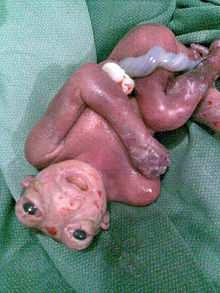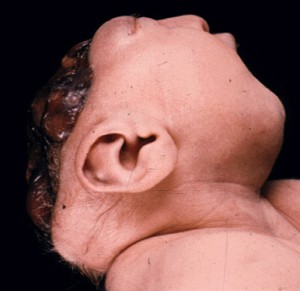Anencephaly is one of the most common defects of the neural tube that has life-threatening consequences for its sufferers. Read about the condition and know all about its causes, symptoms, diagnosis, and treatment options in detail.
What is Anencephaly?
Page Contents
- 1 What is Anencephaly?
- 2 Anencephaly ICD 9 Code
- 3 Anencephaly Incidence
- 4 What Happens in Anencephaly?
- 5 Anencephaly Causes
- 6 Anencephaly Symptoms
- 7 Anencephaly Diagnosis
- 8 Anencephaly Risk Factors
- 9 Anencephaly Treatment
- 10 Anencephaly Complications
- 11 Anencephaly Life Expectancy
- 12 Anencephaly Prevention
- 13 Anencephaly Support Groups
- 14 Anencephaly Pictures
The term “Anencephaly” actually stands for “open skull.” It refers to the lack of a significant portion of the skull as well as the brain. According to NINDS (National Institute of Neurological Disorders and Strokes), the condition generally arises between the 23rd and 26th day of maternity.
Anencephaly ICD 9 Code
The ICD 9 Code of the condition is 740.0.
Anencephaly Incidence
The condition affects 1 out of every 5,000-10,000 newborns. The exact statistical figures associated with the disorder are not known as post of such pregnancies result in miscarriage. The rate of recurrence for the disease is 4-5%. If parents have already given birth to two infants with the condition, the rate can go up to 10-13%.
What Happens in Anencephaly?
In normal cases, the neural tube (a narrow fetal channel), closes to form the brain and the spinal cord. In individuals affected by Anencephaly, this tube fails to close in a proper way between the 3rd and 4th weeks of maternity. Infants born with this condition have some section of their brain missing. Such newborns are usually unconscious. They cannot feel and are usually deaf and blind.
Many infants with this disease have their brain tissue exposed due to the absence of certain portions of their skull. There is an absence of any skin tissue or bone over the regions, which leaves them exposed.
In acute cases, infants are born without any forebrain. The forebrain is a particular region of the brain that is responsible for most thoughts, senses and coordination. The absence of this area leaves a sufferer without the capability to see, move, hear or even remain conscious.
There might be a primitive brain stem in certain sufferers at the time of birth. This stem leads to involuntary actions in such sufferers, who might seem to be able to respond to touch or sound sensations.
Anencephaly Causes
It is not known what exactly leads to this disorder. Doctors and researchers are still in the dark regarding the specific causative reason for the condition. Certain factors are, however, supposed to increase the possibility of neural tube defects, like spina bifida (a birth defect characterized by exposure of the spine) or anencephaly. Intake of some prescription drugs, such as medications used for diabetes, may enhance the risk for having the Anencephaly.
According to some scientists, the disease might originate due to genetic factors or deficiency in the diet of a mother. Physicians have discovered an association between folic acid deficiency and the disorder when the nervous system of a fetus begins to develop during the first month of maternity.
Anencephaly Symptoms
The disorder is typically characterized by the following signs:
- Absence of the brain (cerebellum and the cerebral hemispheres)
- Absence of the skull
- Defects in the heart
- Abnormalities of facial features
In individuals affected by this disease, most sections of the scalp, brain and fetal skull fail to develop completely unlike that in normal individuals.
Anencephaly Diagnosis
The condition is generally diagnosed during ultrasound exams and routine prenatal tests. In certain cases, however, it is recognized at the time of birth. If it is detected prior to birth, more counseling might be required.
The diagnostic exams for this disease comprise of prenatal tests, which include:
Fetal MRI
This imaging exam involves use of a magnet to produce an image of the developing fetus. It can help generate images of the brain and its different structures in greater detail than an ultrasound.
Amniocentesis
It includes insertion of a needle through the abdomen to extract a small quantity of fluid from the amniotic sac. This can be followed up with the analysis of the fluid to assess the levels of acetylcholinerase and alpha-fetoprotein. Levels that are greater than normal are related with neural tube defects like anencephaly.
Blood tests
These exams may show high levels of the protein alpha-fetoprotein, manufactured by the immature fetal liver cells.
Ultrasound
This imaging exam makes use of high-frequency audio waves to generate a sonogram image of the fetus that is developing. The abnormalities related with the condition can be viewed on the sonogram.
Anencephaly Risk Factors
The risk factors for this condition include:
An already affected child
Having an infant already affected with this disease has been found to increase the risk of giving birth to another child with the same condition.
Being female
The condition is supposed to have a sexual predilection as female infants are found to have this disorder more than their male counterparts. This is perhaps due to a greater number of stillbirths or spontaneous abortions in case of male fetuses.
In approximately 90% of all cases of this condition, parents of suffering individuals do not have a family history of it.
Anencephaly Treatment
Unfortunately, there is no treatment for this disease. A child with this condition is provided with supportive care. The newborn is kept warm and any exposed section of his or her brain is kept protected. In certain cases, a special bottle is used in feeding babies who experience difficulties in swallowing fluids.
Parents of babies, who are suffering from this disorder and still surviving, should consult a physician to know about proper care of their child.
Anencephaly Complications
As aforementioned, this is a fatal disorder. In around 75% cases of this condition, affected infants are found to be stillborn. Even newborns who manage to be born alive fail to survive after a span ranging from a few hours to a few weeks.
Anencephaly Life Expectancy
The disorder usually leads to the death of affected infants in a few days after birth. In certain cases, however, the period of survival is found be longer. It is only in exceptional cases that one may come across survivors of this condition.
Anencephaly Prevention
It is difficult to prevent this disorder as its exact causes are not clearly known. Women who are planning for pregnancy should get adequate amounts of folic acid. There is strong evidence that higher amounts of this substance can lower the risk of some birth defects, such as anencephaly. Women planning conception should consume folic acid, along with multivitamin, on a daily basis. Doctors advocate that women who are old enough to give birth should have at least 0.4 mg Folic acid on a daily basis.
Some good natural sources of the acid involve eatables like:
- Oranges
- Orange juice
- Dried beans
- Leafy green vegetables
It is the awareness of such birth defects that has led many foods to be spiked with folic acid to help avoid such birth defects. Such products include:
- Rice
- Bread
- Flour
- Cereals
- Pasta
The synthetic form of folic acid is absorbed and utilized by the body more easily than the form that can be found naturally in foods.
Women who have already given birth to an Anencephaly infant should take higher amounts of the substance before their second pregnancy. They should consult their physicians regarding the appropriate amount of the acid that they should consume. Women who have had an infant with a neural tube defect are recommended to take 4 mg of Folic acid starting 1-2 months prior to conception and continuing through the first trimester of maternity. However, the dosage and consumption should best be monitored by a doctor, to prevent any complications in a mother or her fetus.
Adequate amounts of folic acid can cut down the risk of neural tube defects by half. However, nothing can be done to treat the condition once it actually occurs.
Anencephaly Support Groups
Parents of Anencephaly sufferers can get in touch with any of these organizations to learn more about the condition and how to care after their affected children.
Genetic and Rare Diseases (GARD) Information Center
PO Box 8126
Gaithersburg, MD 20898-8126
Tel: (301)251-4925
Fax: (301)251-4911
Tel: (888)205-2311
TDD: (888)205-3223
Internet: http://rarediseases.info.nih.gov/GARD/AboutGARD.aspx
Birth Defect Research for Children, Inc.
800 Celebration Ave, Suite 225
Orlando, FL 34747
USA
Tel: (407)566-8304
Fax: (407)895-0824
Email: [email protected]
Internet: http://www.birthdefects.org
NIH/National Institute of Child Health and Human Development
31 Center Dr
Building 31, Room 2A32
MSC2425
Bethesda, MD 20892
Fax: (866)760-5947
Tel: (800)370-2943
TDD: (888)320-6942
Email: [email protected]
Internet: http://www.nichd.nih.gov/
Fetal Hope Foundation
9786 S Holland Street
Littleton, CO 80127
USA
Tel: (303)932-0553
Tel: (877)789-4673
Email: [email protected]
Internet: http://www.fetalhope.org
Share Pregnancy & Infant Loss Support, Inc.
402 Jackson Street
Saint Charles, MO 63301
Tel: (636)947-6164
Fax: (636)947-7486
Tel: (800)821-6819
Email: [email protected]
Internet: http://www.nationalshare.org
Anencephaly Pictures
These useful images would help you get an idea about the physical appearance of infants born with this condition.
Picture 1 – Anencephaly
Picture 2 – Anencephaly Image
Anencephaly is one of the most of life-threatening congenital defects with very slim chances of survival for its sufferers. If you have already given birth to an infant with this disorder, it is recommended that you undergo proper genetic counseling and adopt all preventive measures before planning a second pregnancy.
References:
http://www.webmd.com/brain/anencephaly-10725
http://emedicine.medscape.com/article/1181570-overview
http://www.ncbi.nlm.nih.gov/pubmedhealth/PMH0002547/


